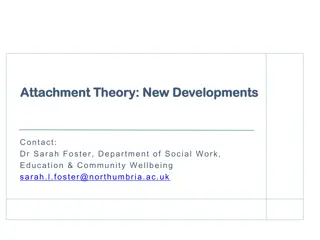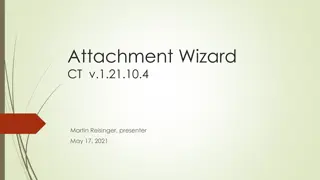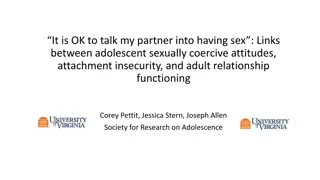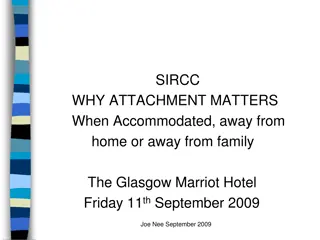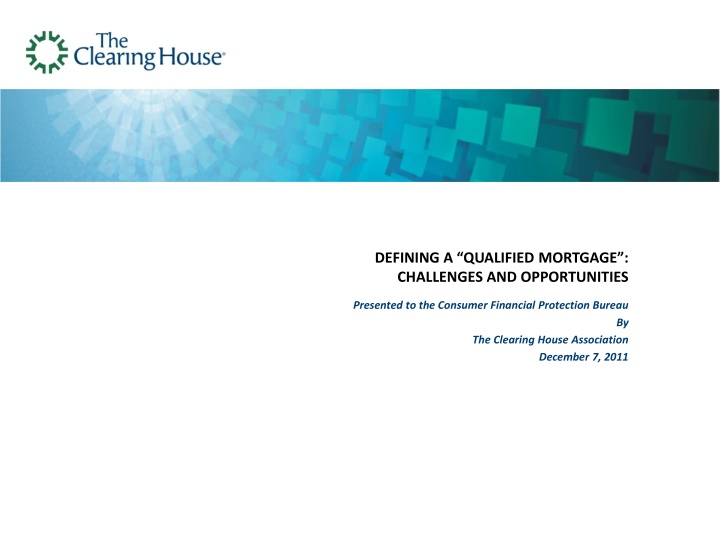
Qualified Mortgages and Risk Management in Lending
Explore the challenges and opportunities presented by defining Qualified Mortgages (QMs) and Qualified Residential Mortgages (QRMs) under the Dodd-Frank Act. Discover how these regulations aim to ensure responsible lending, mitigate risks, and balance borrower accessibility with investor security. Dive into the complexities of setting standards for borrower repayment abilities and risk retention, and the implications for the mortgage market.
Download Presentation

Please find below an Image/Link to download the presentation.
The content on the website is provided AS IS for your information and personal use only. It may not be sold, licensed, or shared on other websites without obtaining consent from the author. If you encounter any issues during the download, it is possible that the publisher has removed the file from their server.
You are allowed to download the files provided on this website for personal or commercial use, subject to the condition that they are used lawfully. All files are the property of their respective owners.
The content on the website is provided AS IS for your information and personal use only. It may not be sold, licensed, or shared on other websites without obtaining consent from the author.
E N D
Presentation Transcript
DEFINING A QUALIFIED MORTGAGE: CHALLENGES AND OPPORTUNITIES Presented to the Consumer Financial Protection Bureau By The Clearing House Association December 7, 2011
BACKGROUND The Dodd-Frank Act seeks to encourage responsible lending by designating certain classes of mortgages as qualified mortgages (QM) and qualified residential mortgages (QRM). While they share a common objective, the two categories are designed to address different weaknesses in the mortgage-delivery chain. Consumers Investors Lender/ Securitizer Ability to repay requirement ensures that borrowers get mortgages they can handle from a financial perspective. Risk retention seeks to align the lender s incentives with those of the investor by requiring lender/issuer skin in the game. As described in the following chart, despite the presence of the basic ability to repay requirements, QMs may effectively determine the outer boundaries of the mortgage market that are consistent with responsible lending. Because of increased and uncertain legal liabilities, pressures from prudential regulators, and heightened compliance and reputational risk, non-QM-mortgage loans are unlikely to be made in significant numbers. QRMs will determine the price differentials that are ultimately built into the mortgage market. Non-QRM mortgages will continue to be made at a price that reflects the cost of risk retention as well as the underlying liquidity of the loans. In crafting the regulations, both QMs and QRMs should be defined in a way that serves the widest range of creditworthy borrowers at the lowest possible cost. 2 The Clearing House Association
QMS VS. QRMS Qualified Mortgage (QM) Qualified Residential Mortgage (QRM) Policy Objective Ensure that borrowers have the ability to repay their loans Improve the quality of lending and securitization by requiring skin in the game What QM/QRM Is Designed To Do Establish specific procedures and criteria to determine a borrower s ability to repay Identify the characteristics of loans that will be exempt from risk retention What Happens if Requirements Are Not Met Consumer has a defense against foreclosure, investor s security interest is threatened, and lender is subject to substantial penalties. Since such risk cannot be quantified, lenders and investors will tend to avoid it Mortgage becomes subject to risk retention Credit risk can be quantified and priced into the mortgage rate Creating a meaningful good loan standard that accommodates a wide range of borrowers who can afford to make the mortgage payment Striking the right balance between skin in the game and cost of credit Challenge to Policymakers Preserving the liquidity of both the QRM and non- QRM markets Ensure a continuous flow of safe and affordable mortgage credit by providing sufficient legal certainty at origination to protect the security interests of investors & avoid frivolous litigation Enabling private capital to compete with FHA and the GSEs If QM defined too narrowly, borrowers who could afford to repay their loans will be denied access to mortgage credit or receive it at a substantially higher cost If QRM defined too broadly, non-QRM market will be illiquid, with rates that are unnecessarily high Risks if Policymakers Get It Wrong If QRM is defined too narrowly, the desired alignment may not be achieved, potentially weakening investor demand If QM defined too broadly, some borrowers may get loans that they cannot afford and will not have the remedies that Congress intended If QM standards are unclear, lenders will not approach the bounds of regulation and lending will decline at the margin 3 The Clearing House Association
DEFINING A QUALIFIED MORTGAGE Challenges The creation of a national QM standard will inevitably serve to codify what is meant by a desirable loan. In defining a qualified mortgage and establishing the specific criteria that must be met policymakers must strike a delicate balance: If the QM definition is too restrictive, borrowers who can afford to repay their loans will be denied credit or receive it at a substantially higher cost. If the QM definition is too broad, some consumers may be placed in mortgages that they cannot afford to repay and they will not have the remedies that Congress intended. Policymakers also need to develop QM standards that are unambiguous, objective and easily applied in the underwriting process. Since virtually anything in the borrower s credit file could be used to overcome a motion to dismiss, a lack of clarity will inevitably raise the specter of frivolous litigation. In the end, consumers will be harmed by reduced access to mortgage credit and higher mortgage rates. Guiding Principles Define QMs as broadly as possible to ensure continued access to sustainable mortgage credit for a wide range of qualified borrowers Establish objective, bright line standards for defining a qualified mortgage so that QM status can be determined at closing Ensure that consumers have access to safe, affordable loans by providing the legal underpinnings that prevent widespread litigation for routine foreclosure actions, preserve and protect the investor s security interest in the property, and encourage the continued flow of capital into the mortgage market. 4 The Clearing House Association
WHY A BRIGHT LINE IS IMPORTANT A lack of bright-line standards will reduce access to mortgage credit and lead to higher mortgage rates. Ambiguous guidelines will inevitably be disputed by borrowers seeking a defense against foreclosure actions, increasing the likelihood of litigation. To minimize these risks, the majority of lenders will either gravitate towards safer loans that are well within the bounds envisioned by policymakers or charge a significant premium for loans that are perceived to be close to the margin. The net result is that many borrowers who could otherwise afford to repay their loans will either be denied credit or offered credit at a significantly higher price. A lack of bright-line standards will reduce liquidity and access to the secondary market. Few, if any, non-QM loans will be sold into the secondary market because of their heightened compliance risk. If an originator, buyer or insurer (including the GSEs) is unable to determine with certainty that a loan meets QM standards at origination, the market for such loans will be illiquid. If QM standards are ambiguous, investors and guarantors are likely to respond by tightening underwriting standards, unnecessarily restricting access to capital. A lack of bright-line standards could open the door for misuse or exploitation by irresponsible lenders. While market pressures and regulatory oversight would presumably serve to keep irresponsible lending in check, recent experience has shown that this outcome is by no means guaranteed. 5 The Clearing House Association
TCH RECOMMENDATIONS: QM DEFINITION Retain proposed product restrictions In addition to income verification, add the following underwriting requirements to the definition of a qualified mortgage: Verification of employment status, if applicable (either written or oral VOE) Documentation of current debt obligations (based on credit report and borrower application) Documentation of payments on simultaneous seconds and any other subordinated loans in place at origination Require that the borrower s total debt-to-income ratio (DTI) be at or below a specific quantitative threshold A specific threshold is required to achieve the necessary clarity. While the appropriate threshold to apply is inherently a policy decision and should be re-examined on a periodic basis Appendix A shows the estimated impact of different back-end DTI cut-offs on recent conventional originations. The CFPB should develop an expanded closing document (e.g., revised HUD1) that provides certainty at the closing table that a loan complies with QM standards. 6 The Clearing House Association
REBUTTABLE PRESUMPTION V. SAFE HARBOR The establishment of a rebuttable presumption versus a legal safe harbor has been a hotly contested issue with seemingly little room for compromise. Proponents of a rebuttable presumption argue that it: Provides additional protection to consumers while having only a minimal impact on compliance risk Ensures accountability and sustainability going forward, since the safe-harbor provision as currently proposed would enable lenders to originate QM loans that exceed the bounds of responsible lending Proponents of a safe harbor including TCH argue that: Without a legal safe harbor, consumers would have the right to use virtually anything contained in their loan files as a potential defense against a foreclosure action, increasing the time and costs associated with foreclosure actions as well as the likelihood of jury trials. Higher costs will translate into higher mortgage rates for all consumers. Because of the elevated compliance risk, a rebuttable presumption will cause the majority of lenders to lend well within the boundaries established for qualified mortgages, unnecessarily restricting access to large numbers of otherwise creditworthy borrowers. Legal clarity associated with a safe harbor is necessary to maintain the flow of capital into housing to the benefit of borrowers by protecting investors security interests. 7 The Clearing House Association
WHY A SAFE HARBOR IS IMPORTANT As long as lenders adhere to responsible lending guidelines, most borrowers ability to repay claims will ultimately fail. However, without a safe harbor, courts will have to resolve issues of fact raised by borrowers seeking to avoid foreclosure via an ability to repay defense, which will lengthen foreclosure timelines. One way to think about the potential impact of a rebuttable presumption on the availability and cost of mortgage credit is to consider the current experience with foreclosures in judicial and non-judicial states: While a variety of factors have caused foreclosure timeframes to lengthen in the past 12 months, differences between judicial and non-judicial states may be illustrative of the potential impact of a rebuttable presumption. The median number of days from first legal action to property sale is 414 days for judicial states and 154 days for non-judicial states, a difference of roughly one year. All else equal, this disparity suggests that adopting a rebuttable presumption could significantly increase foreclosure timeframes, particularly in non-judicial states. The additional time and resources that would inevitably be associated with foreclosure actions would significantly increase the servicer s carrying and legal costs, while lowering recovery values. This will lead to higher mortgage rates and reduced access to credit for all but the least risky borrowers. Longer foreclosure timelines will also have a negative impact on surrounding properties. TCH Recommendation: Expanded Safe-Harbor Provision Expand the proposed safe-harbor provision to include the specific underwriting criteria identified on page 6, including a cap on back-end DTI. Source: Lender Processing Services, as of September 2011. See Appendix B. 8 The Clearing House Association
RECOMMENDATIONS ON POINTS AND FEES In addition to creating an expanded safe harbor for qualifying mortgages, TCH recommends that the CFPB uses its exemption authority to make the following changes to the proposed definition of points and fees: Exclude loan-officer compensation. Including loan-officer compensation (LOC) in the definition of points and fees would result in double-counting since the costs to the borrower are already captured in the lender s origination fees. From an operational perspective, the calculation of LOC would also be infeasible since performance-based incentive payments would typically not be known at the time of origination. Potential abuses associated with compensation have been addressed by the Federal Reserve s compensation rules and other Dodd-Frank provisions. Exclude affiliate fees, including title insurance and borrower-paid mortgage insurance. Bona fide settlement services are necessary for originating loans and should not be included in the 3% points-and-fees limitation regardless of whether they are paid to affiliates or non-affiliates. Creditors maintain settlement-service affiliates to better control the quality and efficient delivery of such services. These entities must comply with the affiliated-business-arrangement provisions of RESPA. Increase caps for loans below $150,000 to ensure continued access to borrowers with smaller loans. Higher caps on points and fees are needed for smaller loans since many components of origination costs are fixed. In our view, a more appropriate structure would be: $125,000-$149,999: 3.5% $75,000-$99,999: 4.5% $100,000-$124,999: 4.0% Less than $75,000: 5.0% Data presented in Appendix C estimates the probable impact of these provisions. 9 The Clearing House Association
CONCLUSIONS The CFPB faces both opportunities and challenges in its efforts to finalize the proposed QM definition. The opportunities relate to the goal of protecting the nation s consumers from irresponsible and abusive lending practices by codifying what is meant by desirable lending. The challenges relate to the need to strike a careful balance between two potentially conflicting policy goals: the desire to promote and encourage responsible lending by ensuring that borrowers receive mortgages that they can afford to repay; and the desire to extend the availability of mortgage credit to the widest range of creditworthy borrowers at the lowest possible cost. We believe that the solution we have proposed a legal safe harbor with an expanded, clearly defined set of underwriting criteria, including a specific DTI cutoff offers a practical way to balance these two objectives. The Clearing House Association and its members would welcome the opportunity for further collaboration on these issues as the CFPB proceeds with its regulatory process. 10 The Clearing House Association
APPENDIX A IMPACT OF ALTERNATIVE DTI CUTOFFS The Clearing House Association
ESTIMATED IMPACT OF DTI CAPS CoreLogic data from 2010 and 2011 was used to estimate the current share of the market that would likely be affected by different DTI caps. The table below shows the share of the conventional market that would be excluded from the QM space because of the imposition of product restrictions and limitations on total DTI. The first column shows the impact of prohibiting interest-only, option-ARM and low-documentation loans, as required. The remaining columns show the additional impact of imposing various caps on DTI. The low-interest-rate environment, the predominance of refinancings, and the depressed housing market may make these results less indicative of market impact going forward. However, the results presented below are roughly similar to those observed at the beginning of the decade, before underwriting standards began their precipitous decline. Percent of Loans Excluded Under Different DTI Caps Product Type +45% DTI Cap +50% DTI Cap +55% DTI Cap 2010 17.4% +3.9% +0.6% +0.3% 2011 10.5% +3.5% +0.8% +0.3% Source: CoreLogic, PNC CoreLogic data do not enable one to identify other prohibited product types (e.g., certain balloons). The relatively large reductions associated with restrictions on product type primarily reflect streamlined refinancings under programs such as HARP. 12 The Clearing House Association
ESTIMATED IMPACT OF DTI CAPS (CONT.) The following table compares the LTV distributions of (i) mortgage loans that would be classified as non-QM loans under the different back-end DTI caps to (ii) those loans that would continue to meet QM standards. Ineligible product types have been excluded from the analysis. While the majority of non-QM mortgages would have LTVs at or below 80 percent regardless of the DTI cutoff that is used, higher cutoffs appear to have a disproportionate effect on higher LTV loans. Impact of DTI Caps on LTV Distribution: 2011 Conventional Loans 45% DTI Cap 50% DTI Cap 55% DTI Cap LTV Non-QM QM Non-QM QM Non-QM QM 80 86.7% 85.0% 59.3% 85.2% 62.0% 85.1% 80-90 6.0% 8.5% 20.6% 8.4% 23.0% 8.4% 90-95 3.7% 5.2% 12.2% 5.1% 12.6% 5.1% 95+ 3.1% 1.2% 6.1% 1.2% 1.1% 1.3% No Data 0.6% 0.1% 1.7% 0.1% 1.2% 0.1% Total 100.0% 100.0% 100.0% 100.0% 100.0% 100.0% Source: CoreLogic, PNC 13 The Clearing House Association
APPENDIX B FORECLOSURE TIMELINES 14 The Clearing House Association
FORECLOSURE TIMELINES Without a legal safe harbor, foreclosure timelines will inevitably lengthen since courts will have to address any issues of fact that might be raised by a borrower seeking to forestall a foreclosure action. While a variety of factors have caused foreclosure timeframes to lengthen in the past 12 months, differences between judicial and non-judicial states may be illustrative of the potential impact of a rebuttable presumption. As shown in the following charts, the median number of days from first legal action to property sale is 414 days for judicial states and 154 days for non-judicial states, a difference of roughly one year. All else equal, this disparity suggests that adopting a rebuttable presumption could significantly increase foreclosure timeframes in non-judicial states. A rebuttable presumption could also add to foreclosure timelines in judicial states, since a higher percentage of foreclosure actions could be disputed and end up in trial. Longer foreclosure timeframes will inevitably increase the carrying and legal costs that are associated with foreclosure actions. In addition, longer foreclosure timeframes will most likely reduce recovery values, as illustrated by slides comparing the house-price recovery in California (a non-judicial state) to that observed in Florida (a judicial state). 15 The Clearing House Association
COMPARING FORECLOSURE TIMELINES BETWEEN STATES WITH JUDICIAL AND NON-JUDICIAL FORECLOSURE PROCESSES Median number of days from 1st legal action to sale of property is 414 days for judicial states and 154 days for non-judicial states. On aggregate, it takes slightly less than one year (~320 days) for the typical foreclosure loan to go from first legal action to the sale of the property. Days from first legal action to property sale (data available for 23 judicial states and 26 non-judicial states) Max 1000 days The foreclosure process in judicial states ranges from approximately 200 days to 1,000 days, with an average of ~400 days. The foreclosure process in non-judicial states ranges from approximately 500 days to less than 100 days, with an average of ~180 days. 500 days Max While a variety of factors have led to a lengthening of foreclosure timeframes, differences between judicial and non- judicial states are broadly illustrative of the potential impact of a rebuttable presumption, which will require courts to rule on issues of fact. 250 days Min 100 days Min Judicial States Non-Judicial States Source: LPS data as of September 2011 16 The Clearing House Association
COMPARING FORECLOSURE INVENTORY BETWEEN STATES WITH JUDICIAL AND NON- JUDICIAL FORECLOSURE PROCESSES: CALIFORNIA VS. FLORIDA EXAMPLE Comparison of California s foreclosure inventory vs. Florida s foreclosure inventory While the foreclosure inventory of California (a non-judicial state) grew through early 2009, the last 18 months have shown a reduction in overall foreclosure-inventory rates back to 2008 levels as properties have worked their way through the foreclosure lifecycle. Historical Foreclosure Inventory (as a percent of loans serviced) 16% 14% 12% Florida (a judicial state) has grown to 4X the foreclosure inventory of California and has shown no clear signs of abatement, with inventory remaining relatively flat at ~14%. 10% 8% 6% 4% A similar relationship exists at a national level across judicial vs non-judicial foreclosure states. 2% 0% Q1 Q2 Q3 Q4 Q1 Q2 Q3 Q4 Q1 Q2 Q3 Q4 Q1 Q2 2008 2009 2010 2011 California Florida Source: MBA delinquency-survey data sourced from Moody s Analytics 17 The Clearing House Association
COMPARING HOME PRICES BETWEEN STATES WITH JUDICIAL AND NON-JUDICIAL FORECLOSURE PROCESSES: CALIFORNIA VS. FLORIDA EXAMPLE Extended forecast of housing-price index (HPI): California vs. Florida Florida (a judicial-foreclosure-process state) home-price recovery is estimated to be 3 years longer than California s (a non-judicial-foreclosure-process state). Historical & Forecasted HPI (Q1 2006 Q4 2022) Forecasted HPI 250 This, after an initially steeper decline in HPI in CA 230 210 This forecast of higher projected HPI in non-judicial foreclosure states relative to judicial foreclosure states is also consistent at a national level. 190 14.5 years 11.25 years 170 150 130 110 Historical and forecasted HPI data are from Moody s Economy.com. 2007Q1 2008Q1 2009Q1 2012Q1 2013Q1 2014Q1 2016Q1 2017Q1 2018Q1 2021Q1 2022Q1 2006Q1 2010Q1 2011Q1 2015Q1 2019Q1 2020Q1 California HPI Florida HPI Source: Case-Shiller Home Price Index Forecasts, sourced from Moody s Analytics (September 2011 update) 18 The Clearing House Association
APPENDIX C IMPACT OF CERTAIN LIMITATIONS ON POINTS AND FEES 19 The Clearing House Association
APPROACH Data from 2011 originations were used to estimate the share of loans that would exceed the proposed 3% cap under different assumptions regarding the specific items that were subject to the cap. The sample was restricted to conventional loans originated through retail channels; the results presented here were derived by averaging the data provided by individual banks. The impact of including affiliate fees was estimated by comparing the share of loans that exceed the 3% threshold under two different assumptions: All closing costs are included (where closing costs are defined as credit reports, appraisal, and title). All closing costs are excluded. Because of uncertainties regarding the definition of bona fide discount points, two scenarios were considered: All discount points are included. All discount points are excluded. Loan-officer compensation (LOC) was estimated based on averages that were appropriate to each institution. Data Source: Data were provided by several participating banks based on their recent originations. To protect the confidentiality of the data, data from each participant were sent to a third-party aggregator and subsequently merged and anonymized. Data for individual participants were treated as confidential and made available to no other Clearing House institution. The data were generated for the sole purpose of assisting the CFPB on issues related to its rulemaking on the definition of a qualified mortgage. 20 The Clearing House Association
SUMMARY OF RESULTS PERCENT OF LOANS THAT EXCEED 3% CAP: CONVENTIONAL RETAIL LOANS Scenario 1: Scenario 2: Scenario 3: Scenario 4: All Loans By Loan Size: $150,000 $75,001 - $149,999 $75,000 21.3% 16.4% 6.5% 2.6% 8.2% 33.0% 82.0% 5.9% 23.5% 73.5% 3.1% 7.7% 27.4% 0.4% 2.5% 19.5% Point/Fee Element 1. LOC 1. Closing Costs 1. Discount Points Scenario 1: Include Include Include Scenario 2: Exclude Include Include Scenario 3: Exclude Exclude Include Scenario 4: Exclude Exclude Exclude Data Source: Estimates are based on 2011 origination data from TCH member banks. In order to protect the confidentiality of the data, data from each participant were sent to a third-party aggregator and subsequently merged. The estimates in the chart are simple averages of the results provided by different institutions. Data for individual banks were treated as confidential and were not made available to TCH members. 21 The Clearing House Association


